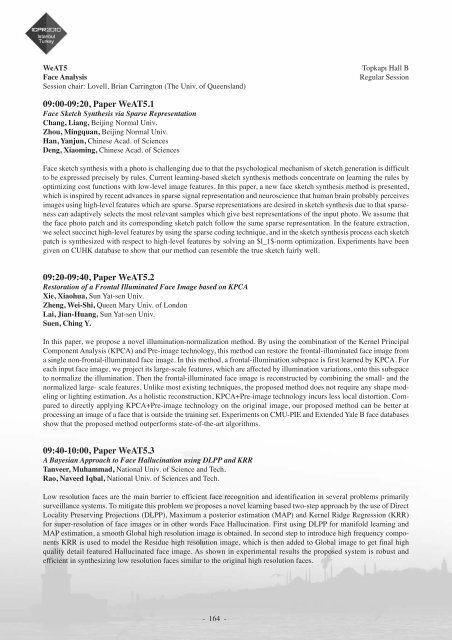Abstract book (pdf) - ICPR 2010
Abstract book (pdf) - ICPR 2010
Abstract book (pdf) - ICPR 2010
- TAGS
- abstract
- icpr
- icpr2010.org
Create successful ePaper yourself
Turn your PDF publications into a flip-book with our unique Google optimized e-Paper software.
WeAT5 Topkapı Hall B<br />
Face Analysis Regular Session<br />
Session chair: Lovell, Brian Carrington (The Univ. of Queensland)<br />
09:00-09:20, Paper WeAT5.1<br />
Face Sketch Synthesis via Sparse Representation<br />
Chang, Liang, Beijing Normal Univ.<br />
Zhou, Mingquan, Beijing Normal Univ.<br />
Han, Yanjun, Chinese Acad. of Sciences<br />
Deng, Xiaoming, Chinese Acad. of Sciences<br />
Face sketch synthesis with a photo is challenging due to that the psychological mechanism of sketch generation is difficult<br />
to be expressed precisely by rules. Current learning-based sketch synthesis methods concentrate on learning the rules by<br />
optimizing cost functions with low-level image features. In this paper, a new face sketch synthesis method is presented,<br />
which is inspired by recent advances in sparse signal representation and neuroscience that human brain probably perceives<br />
images using high-level features which are sparse. Sparse representations are desired in sketch synthesis due to that sparseness<br />
can adaptively selects the most relevant samples which give best representations of the input photo. We assume that<br />
the face photo patch and its corresponding sketch patch follow the same sparse representation. In the feature extraction,<br />
we select succinct high-level features by using the sparse coding technique, and in the sketch synthesis process each sketch<br />
patch is synthesized with respect to high-level features by solving an $l_1$-norm optimization. Experiments have been<br />
given on CUHK database to show that our method can resemble the true sketch fairly well.<br />
09:20-09:40, Paper WeAT5.2<br />
Restoration of a Frontal Illuminated Face Image based on KPCA<br />
Xie, Xiaohua, Sun Yat-sen Univ.<br />
Zheng, Wei-Shi, Queen Mary Univ. of London<br />
Lai, Jian-Huang, Sun Yat-sen Univ.<br />
Suen, Ching Y.<br />
In this paper, we propose a novel illumination-normalization method. By using the combination of the Kernel Principal<br />
Component Analysis (KPCA) and Pre-image technology, this method can restore the frontal-illuminated face image from<br />
a single non-frontal-illuminated face image. In this method, a frontal-illumination subspace is first learned by KPCA. For<br />
each input face image, we project its large-scale features, which are affected by illumination variations, onto this subspace<br />
to normalize the illumination. Then the frontal-illuminated face image is reconstructed by combining the small- and the<br />
normalized large- scale features. Unlike most existing techniques, the proposed method does not require any shape modeling<br />
or lighting estimation. As a holistic reconstruction, KPCA+Pre-image technology incurs less local distortion. Compared<br />
to directly applying KPCA+Pre-image technology on the original image, our proposed method can be better at<br />
processing an image of a face that is outside the training set. Experiments on CMU-PIE and Extended Yale B face databases<br />
show that the proposed method outperforms state-of-the-art algorithms.<br />
09:40-10:00, Paper WeAT5.3<br />
A Bayesian Approach to Face Hallucination using DLPP and KRR<br />
Tanveer, Muhammad, National Univ. of Science and Tech.<br />
Rao, Naveed Iqbal, National Univ. of Sciences and Tech.<br />
Low resolution faces are the main barrier to efficient face recognition and identification in several problems primarily<br />
surveillance systems. To mitigate this problem we proposes a novel learning based two-step approach by the use of Direct<br />
Locality Preserving Projections (DLPP), Maximum a posterior estimation (MAP) and Kernel Ridge Regression (KRR)<br />
for super-resolution of face images or in other words Face Hallucination. First using DLPP for manifold learning and<br />
MAP estimation, a smooth Global high resolution image is obtained. In second step to introduce high frequency components<br />
KRR is used to model the Residue high resolution image, which is then added to Global image to get final high<br />
quality detail featured Hallucinated face image. As shown in experimental results the proposed system is robust and<br />
efficient in synthesizing low resolution faces similar to the original high resolution faces.<br />
- 164 -



